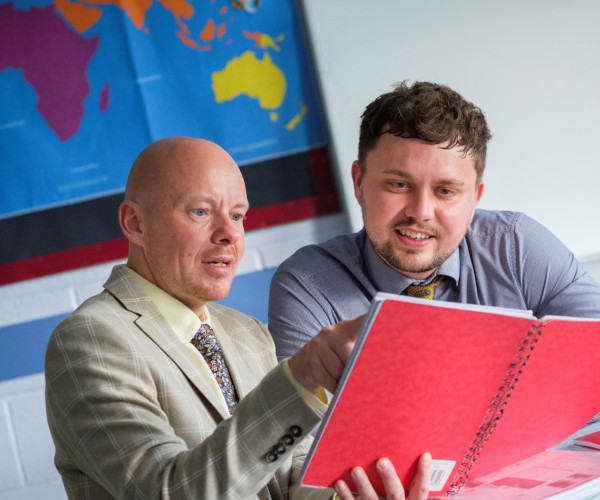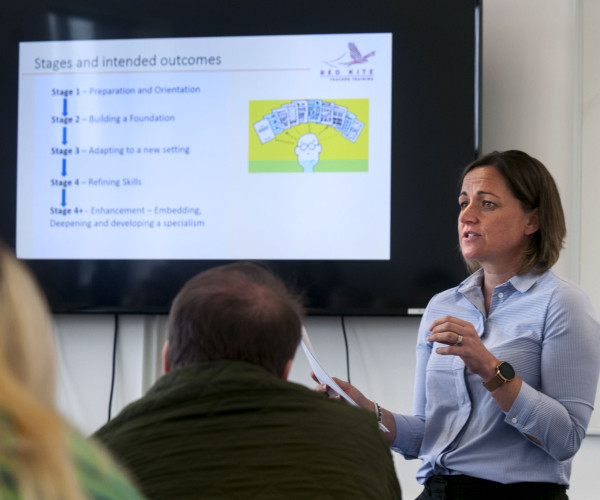Spotlight on Teacher Wellbeing and Professional Growth
Posted 7th May 2024
Julia Dickson, Headteacher at The Whartons Primary School in Otley, recently completed her Masters degree. In this article, Julia shares her research offering an insight into the intersection of teacher wellbeing, engagement, and self-efficacy within an experienced teaching team. Drawing on her extensive experience in the field and a passion for continuous improvement, Julia embarked on a journey to explore the impact of teacher-led CPD on fostering a supportive learning environment in her team. Through rigorous analysis and innovative approaches, Julia sheds light on the challenges, successes, and lessons learned from implementing this transformative initiative.

How does the introduction of teacher led CPD and the creation of a supportive learning environment for teachers, affect teacher wellbeing, engagement and self-efficacy within an experienced teaching team?
Over recent years increased demands on teachers, during and following the COVID pandemic necessitated changes in teaching and learning approaches; from creation of infection safe environments, to remote learning and recovery curriculum designs. These new demands coincided with changes to the Ofsted inspection framework, raising accountability, especially for subject leaders.
There has been a wide focus on teacher wellbeing in the midst of these challenging changes and extra responsibilities. Teachers within school were displaying signs of fatigue, alongside a reduction in self-efficacy and engagement in professional development.
The teaching team had grown in expertise through the journey but a fall in morale and wellbeing, echoed across the profession, was beginning to impact negatively on teacher self-esteem, engagement, and proactivity.
With a view to support teacher wellbeing and reinvigorate teachers’ passions for their professional development, a new approach to support positive professional development was considered.
The vast majority of the teaching team had 10 years+ of experience and this too may impact on the scope of continual improvement and on outcomes of overall teaching approaches, which can plateau at 10 years+ experience. (Kraft and Papay, 2014, p489).
Over my time in the profession, I have found that continually researching new approaches, considering innovative strategies and being inspired by others, has not only developing my expertise, but ensured continued motivation and a passion for the profession. This is something I wished to share with my teaching team.
Townsend et al (2023) highlight that the teaching has one of the lowest autonomy levels when compared to other professions. Autonomy increases little with experience, as much that a class teacher does is prescribed- from content to timings.
Research into the positive impacts of supportive environments for teacher learning, facilitation of effective collaboration and making time for teacher reflection and leadership is extensively documented. Reported outcomes show the potential for teachers to flourish.
Researching into approaches which may support teacher wellbeing, whilst reinvigorating drive and self-efficacy of an experienced but weary teaching team, led to consideration of how changes to CPD might impact on morale and engagement. This alongside raising autonomy, which aligns with Townsend et al (2023) and Pass (2021), who suggest that CPD is a strong vehicle in raising autonomy.
The NHS’ 5 a Day for Mental Health’ espoused the benefits of meaningful learning to increase wellbeing and support individuals to flourish. Many research studies highlighted the potentially positive development of professional learning environments on teacher engagement and satisfaction, subsequently raising outcomes for children (Murphy et al, 2020; Opfer & Pedder, 2011; Cherkowski, 2018, Pass, 2021). A wide range of studies considered the important role CPD plays in the creation of a productive, dedicated and intrinsically motivated workforce, with a growth mindset they can model to children (Vangreiken, et al, 2015).
With these areas in mind, I sought to develop an improved practice of CPD. Taking some of the ideas from previous research and theory to shape into a design which could support my teachers whilst being relevant and appropriate for our unique setting.
I considered a wide range of published research approaches. Analysing the pros and cons of each, considering the cautionary suggestions, I decided that planning in time for collaboration was possibly one of the most important approaches. Alongside this was to engineer time out of the working week to lead teachers’ own CPD, exploring what was important to them.
I wished to measure impact on not only wellbeing and motivation, but a reinvigorated self-belief/self-efficacy and proactive engagement in self-led professional development (PD), benefitting the individual and the wider team. After a discussion with teachers about their feelings around professional development, their motivations, and the barriers to a positive and productive working environment; a range of selected strategies, was chosen. A new CPD approach introduced for a 12-week block.
In preparation participants were asked to choose an area of personal/professional development which interested them. There were no restrictions to the focus area and the ideas and subsequent projects were wide ranging. The introduction of Boomwackers to support focus and sensory feedback for pupils with SEND, to collaborative lesson studies which explored duel coding in STEM subjects.
During the project period staff meetings were suspended, time disaggregated into personal study to facilitate research, best practice visits, planning lesson studies etc. Alongside this, a 20-minute collaborative coaching slot for all teachers was timetabled into the week. Teachers were released for this Side-by-Side intervention (Gracie and Hopper, 2023) to enable professional conversations about individuals’ projects.
To build a holistic picture of any impacts of the research project, I used a case study design, observing behaviours in context. Also using pre and post intervention surveys to measure wellbeing and perceived stress levels of staff (Anne Freud Centre and Warwick University) . As part of the annual performance management cycle, I carried out interviews to gather participant views and scrutinised the school’s CPD log documentation to ascertain statistical rises or falls in engagement, alongside any trends or patterns in CPD activity.
The issue of how teacher wellbeing can be raised, resilience and self-belief/worth rebuilt are key areas in understanding how to support the profession through the aftermath of COVID; reinvigorating individuals and teams. A wide range of research suggested potential positive impacts of creating conducive learning environments which support teachers’ productivity, through collaboration, teacher leadership and increased time for reflection. This said, little attention has been paid to the challenges of creating these productive spaces for small teams, with limited resources, within financially challenged one form entry primary schools. Therefore, I set out in my research to explore how teachers’ wellbeing, self-efficacy and engagement would be affected by supporting teacher led CPD projects, making time for collaboration and reflection. Thus, adding to the research base, whilst bringing creative solutions to the facilitation of suggested approaches. This was challenging but is common across many small schools.
With the aforementioned in mind, changes did need to be made to plans during the research project. Due to lack of resourcing and cover available, to facilitate Side-by-Side coaching partner time within the school day, as suggested by Gracie and Hopton (2023), it was necessary to cover teachers myself by leading an extra whole school assembly. This reduced the opportunity for my observations of coaching collaborations; reducing the primary source data, and resulting detailed analysis, of the impact sessions had on participants. The observations for these meetings were therefore fleeting, although as individuals referred to them through interviews, impact could be measured here.
In answer to my original research question, there were some measurable impacts on wellbeing, self-efficacy and engagement of the teaching team. Teachers appeared more positive and proactive, enjoying learning new approaches and sharing these with colleagues. This endorsed the findings of Murphy et al (2020) and agreed with the suggestions of Cherkowski (2018) when they referred to positive, supportive environments enabling flourishing teachers. The positive impact on disaggregated study time also had a positive impact on work-life balance.
Implementation of a teacher led approach to CPD, via secured dedicated time for teacher leadership and research, within teachers’ directed time (without adding to workload) appeared very motivational for teachers. Resulting in creative and impactful projects. This was confirmed by the range and depth of CPD activities identified in the CPD log scrutiny, alongside observations of new approaches which teachers established and shared with colleagues, also through the analysis of performance management review interviews.
Establishing weekly collaborative coaching sessions raised wellbeing scores and reduced perceived stress levels, as indicated by pre and post project wellbeing questionnaires. This assumption was verified by interview themes. The teacher led projects appear to have raised self-efficacy and proactive engagement for most participants, as evidenced and corroborated through enthusiasm in teacher interviews, extensive and progressive CPD log journeys and participants’ increased engagement and positivity; the buzz observed in feedback meetings when compared to previous staff CPD meetings.
Although the research project returned some measurably positive improvements there were limitations. Facilitating release time for teacher research and project leadership was challenging and had a negative impact on weekly staff meetings. Meetings are necessary to update teams on school issues, or for whole school essential CPD. This is an area which needs to be considered moving forwards, potentially alternating the self-led study sessions with whole team focus meetings. Another key limiting factor revealed was sustainability of Head Teacher cover needed to facilitate collaborative paired coaching sessions. A creative approach to releasing teachers needs to be considered in future. However, this will be limited by availability of cover for every teacher at the same time.
We will continue to tweak the structure and approaches moving forward but all staff agreed they would like the model to continue.



